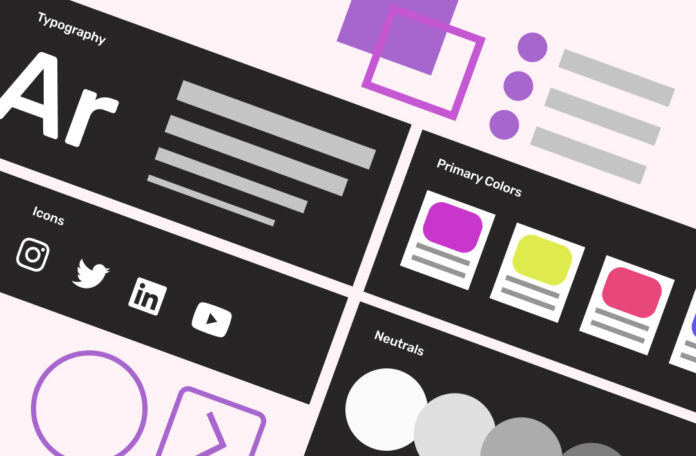
Best 9 Benefits Of Having A Design System will be described this article. In the field of web design, design systems are becoming more and more significant. Why? because they let you communicate design decisions with other team members, organize your design workflow, and produce reusable and consistent components. This article will discuss the benefits creating a design system and offer some advice on how to do it. Are you prepared to begin? Now let’s move!
Best 9 Benefits Of Having A Design System
In this article, you can know about Best 9 Benefits Of Having A Design System here are the details below;
What is a Design System?
A design system is a collection of conventions, patterns, and design ideas that aid in the production of dependable, superior user interfaces. Making it simple for you to create user interfaces that feel and look nice across various platforms, applications, and devices is the aim of a design system.
Any kind of interface, from product designs and graphics to websites and apps, may be created using a design system. Using a design system has several advantages; it not only improves the appearance and consistency of your designs, but it also makes it simpler for you to update and manage them.
Establishing a list of your interface’s essential elements is a smart place to start when creating your design system. You can begin developing patterns and standards for these elements once you have a fundamental understanding of them. Using a design system will ultimately make your work easier and faster overall, in addition to assisting you in producing better user interfaces. Also check AI Media Monitoring Tools To Track Mentions
The benefits of having a design system
Having a design system in place might help you improve consistency and efficiency in your design operations. Additionally, it might help you save time and money by standardizing your designs across several projects. The following are a few advantages of having a design system:
Promotes consistency
You may encourage consistency among your user interfaces by using a design system. This is so that you can produce designs that have a unified, recognizable style by using the standards and patterns it offers. Users will consequently be less likely to detect discrepancies between various platforms or apps.
Reduces the need for manual adjustments
Standard patterns and rules for aspects like typography, layout, color palettes, etc. are frequently included in design systems. The purpose of these guidelines is to lessen the necessity for manual design modifications. Because you won’t need to make these adjustments on a regular basis throughout your tasks, you’ll save time.
Helps to speed up the design process
Generally speaking, a well-designed system will save you time in the creation and maintenance of user interfaces. This is so that things will be simpler for you and you can rely on a set of established conventions. Additionally, while creating new pieces or features, applying patterns might aid in minimizing the amount of research needed.
Scalability
A well-designed system scales effectively for larger teams and is easily adaptable to diverse tasks. This is due to the fact that it follows well-established, simple-to-follow patterns and standards. You’ll be able to produce designs more quickly and accurately as a result, saving you both money and time.
Gets everyone on the same page
Ensuring that all project participants are operating under the same set of standards can be achieved with the aid of a design system. This guarantees uniformity and gets rid of any possible disputes or conflicts. Your staff will be able to collaborate more successfully and efficiently as a result.
Helps to improve user experience
The goal of a well-designed system should be to create designs that are simple to use and comprehend. This implies that users can swiftly and easily explore your interfaces and locate what they’re looking for. It also helps reduce the time people need to spend learning how to utilize your applications. Put simply, design systems result in satisfied users! Also check No Code Tools
Reduced building time
A design system can cut down on the time it takes to create user interfaces since it follows known conventions. This is because you won’t have to spend time researching new components or features every time you design a new user interface. You’ll also save time when developing and testing layout designs if you use patterns.
Reduced development costs
Your procedures and methods will become more consistent across projects with the aid of a well-designed system. This will thus lower the price of creating and maintaining your apps. Using common patterns in particular will help to cut down on the amount of code required for different activities. Additionally, a well-designed system will lessen the amount of rework needed when modifications are made to already-existing applications.
Allow room for innovation
With a design system, you may try new things and create new features without worrying about generating misunderstandings or conflicts. This is so that you will have a set of guidelines that all users will follow thanks to the system. Furthermore, by adhering to conventions throughout your project, you can lessen the amount of the trial and error involved in creating new features.
How to implement a design system
The processes necessary to develop a design system will change based on the particular requirements of your company. Nonetheless, the following general advice could be useful:
- Clearly state the issue that needs to be resolved. Once you have a clear idea of what you want, it is critical to identify the issue. This can be achieved by first comprehending the objectives and demands of the client, and then creating solutions that cater to those needs.
- Create a prototype – Creating a prototype is a useful method to see if the design solutions you’ve come up with are indeed fixing the issue. User research or the development of a low-fidelity prototype that can be tested with different solutions are two ways to accomplish this.
- Refine and adjust – Your design system will probably require refinement and adjustment as you use it more and test it against real-world scenarios. Here’s where conducting additional user or prototype testing is helpful in determining whether or not your solutions are fulfilling customer needs.
- Make it sustainable – After you’ve created a design system that functions effectively in the near term, it’s critical to ensure that it remains viable in the long run. This entails making sure that as your company develops and adapts, your design system stays current and useful.
Why build a design system?
Any organization can benefit from developing a design system for the following primary reasons. First off, if you use standards throughout your project, you can lessen the amount of trial and error that is necessary while creating new features. Second, by adhering to norms throughout your project, you can facilitate collaboration with other designers and developers on related projects. Last but not least, developing and keeping up a design system can be particularly useful during transitions because it will make sure that your current user base isn’t left behind as you make changes to other areas of the website or app.
Common Challenges when building a design system
When developing a design system, there are a few typical problems that can occur. The following are some of the more typical ones:
- Maintaining consistency across platforms and devices in your design system – As your design system expands, it gets harder to keep your designs coherent and consistent. When you need to add or modify your designs for various platforms or devices, this can get very difficult.
- Making sure your design system has all the necessary files – PSDs, source files, style sheets, and other types of files are frequently needed by design systems. Keeping track of which files are necessary and where to put them in your design system can be challenging.
- Keeping an overview of your design system – It gets harder and harder to stay on top of everything at once as your design system gets bigger and more sophisticated. This may result in irregularities and issues with the functionality and appearance of your creations.
Don’t worry if you’re facing any of these difficulties; there are several tactics you can use to get past them. For instance, you can make the system easier to use by grouping related concepts into reusable modules, organize and monitor changes with the aid of tools like version control or documentation, or include built-in feedback mechanisms that allow designers to swiftly assess and modify their work.
Furthermore, always be willing to try new things; if something is effective for someone else, it’s probably worth a go for your own project.
Conclusion
Given the previously listed factors, it is evident why a design system is important. In actuality, you cannot increase your inventiveness and creativity in terms of user experience without a sound design system.
You can guarantee that the users will have a better user experience than they were accustomed to by putting a design system into place at work. Not only that, but your company’s staff will flourish in their workplace with such a fantastic platform for creativity and collaboration! Thus, bear in mind that creating a design system is always a good idea while working on improving products or creating new experiences for your clients!










